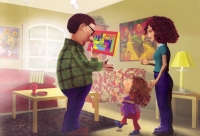| ________________
CM . . .
. Volume XIII Number 8 . . . .December 8, 2006
excerpt:
Mia's Secret is the story of a very young girl who is being abused by a male friend of her mother's. Peter Ledwon tells her story with sensitivity, using simple language that evokes the various emotions that Mia experiences. The predator gains Mia's trust by pretending to be her friend. He listens to what Mia says, he makes her laugh, he plays her favourite games with her and he brings her presents. After gaining her confidence, he introduces his "special game" which is to be kept a secret. He makes Mia promise not to tell about the game, or he won't show it to her. When Mia says that she must tell Tikki, her teddy bear, he grudgingly allows that but makes her promise not to tell anyone else. The game hurts Mia, and she doesn't like it, but she wants to be his friend even though playing the game seems wrong. The abuse continues. On one occasion, Mia is crying. The man and Mia hear her mother coming. He tells Mia's mother that Mia has hurt her knee. Her mother can't find anything wrong with the knee, and, because it is late, she puts Mia to bed. Another time, Mia tries to tell her mother about the secret game without breaking her promise to the man, but she can't make her mother understand. Her mother thinks she is feeling ill. She puts Mia to bed and lovingly looks after her. In the end, Mia solves the problem. She uses Tikki to tell because Tikki hasn't promised to keep the game secret. There is no indication as to what the mother's reaction and actions are in response to hearing about the abuse. However, just before Tikki "talks," Mom has given Mia and Tikki a big hug and told Mia that she has been worrying about her and asks her if she is okay. She also leans in closer to hear what Tikki is saying. From these actions, it can be assumed that she will get Mia whatever help is needed and will protect her.
Highly Recommended. Jeannette Timmerman is a former teacher, consultant and administrator in the Winnipeg (MB) School Division.
To comment
on this title or this review, send mail to cm@umanitoba.ca.
Copyright © the Manitoba Library Association. Reproduction for personal
use is permitted only if this copyright notice is maintained. Any
other reproduction is prohibited without permission.
NEXT REVIEW |
TABLE OF CONTENTS FOR THIS ISSUE
- December 8, 2006.
AUTHORS |
TITLES |
MEDIA REVIEWS |
PROFILES |
BACK ISSUES |
SEARCH |
CMARCHIVE |
HOME |

 The illustrations by Peter Ledwon and Marilyn Mets are excellent in supporting the story. Mia, her mother and the man have a "doll-like" quality to them. The rooms in the house are uncluttered and appealing. They, too, support the story by showing things to be "normal" so children should be safe when, in fact, Mia isn't. Colours are bold in the action areas and more muted in the backgrounds. The body language depicted in the pictures adds to the emotional impact of the book. The difference in size between the man and Mia is emphasized. For example, the man's hand is huge when he grabs Mia's slight arm from elbow to wrist when he is angry because she has told him to go away so they won't play the secret game.
The illustrations by Peter Ledwon and Marilyn Mets are excellent in supporting the story. Mia, her mother and the man have a "doll-like" quality to them. The rooms in the house are uncluttered and appealing. They, too, support the story by showing things to be "normal" so children should be safe when, in fact, Mia isn't. Colours are bold in the action areas and more muted in the backgrounds. The body language depicted in the pictures adds to the emotional impact of the book. The difference in size between the man and Mia is emphasized. For example, the man's hand is huge when he grabs Mia's slight arm from elbow to wrist when he is angry because she has told him to go away so they won't play the secret game.